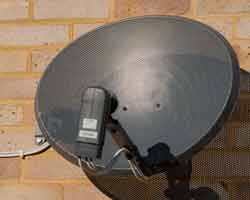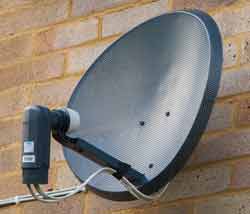Satellite TV Antenna or Dish
Satellite TV antennas or dishes are commonplace and used for receiving satellite television or DBS, direct broadcast transmissions in the home.
Home » Antennas & Propagation » this page
TV antennas guides include:
Types of TV antenna
Buying a TV antenna
TV antenna direction alignment & pointing
TV transmitter finder app
TV antenna alignment meter
Buying TV antenna amplifier / booster
Indoor TV antenna & set-up
Satellite TV dish installation
How to wire a TV antenna socket
Why doesn't a TV antenna work any more
General antenna installation guides
Antenna installation guide
Attic installation
Antenna height
Satellite television antennas or "dishes" are used where satellite television broadcasts or direct broadcasts, DBS from satellites need to be received.
The satellite television antennas are not expensive, but as a result of the frequencies used for these broadcasts, some of the technologies used are slightly different to those used for terrestrial television reception.

To better understand what is needed for a satellite TV antenna installation, it helps to understand what the overall satellite television or satellite dish installation includes and what each section contributes.
Advantages of satellite television
There are several advantages of satellite television over terrestrial television. These result from the frequencies being used as well as the position of the satellite.
A satellite dish installation, or satellite TV antenna installation will enable satellite broadcasts to be received.
One of the main advantages of satellite television is that the frequencies on which the broadcasts are transmitted enables much more spectrum or space to be available for the various channels.
Typically this means that many more channels can be received, giving a much greater variety of programmes from which to choose.
Another advantage of using a satellite television installation is that the spectrum available allows for much higher quality transmissions to be used.
Although terrestrial television provides some very high quality transmissions, the spectrum space is more limited and the very high quality transmissions cannot be accommodated.
Another advantage of using satellite television arises from the fact that the satellites are located many thousands of miles above the Earth. This means that in most areas of the globe they are able to provide very good coverage.
Sometimes terrestrial coverage may be poor as a result of the transmitting stations being located long distances away, or hills may block the transmission path. Satellite television is able to give much better coverage.
As satellite revision uses satellites placed in geostationary orbits which sit in the same place above the Earth, and this means that they have to be above the equator, coverage towards the poles is poor.
Satellite television installation basics
To receive satellite television broadcasts, a TV antenna capable of receiving the satellite broadcasts is required as well as a television that can cover the required frequencies and also power the electronics in the satellite television antenna.
The system for a satellite television installation is a little different to that required for terrestrial television.
The overall satellite dish installation requires a number of different elements:
Satellite dish antenna: This refers to the antenna itself. Typically parabolic reflector antennas are used as these operate well at the frequencies used, giving high levels of gain within a relatively small space.
LNB / LNBF: The satellite TV LNB or low noise block is used to amplify the signal at the antenna and convert it to a lower frequency that can be fed along coax feeder with acceptable levels of loss.
Coaxial feeder: The coax feeder is used to transport the signal from the low noise block to the television receiver.
Satellite capable television / set top box: the satellite television or set top box receives the down-converted signals within the required band and also supplies power along the centre conductor of the coax feeder to power the satellite TV LNB or LNBF.
Deeper descriptions and explanations of these different elements of a satellite antenna installation are given below.
Satellite antenna
The satellite TV antenna or dish is a form of radio antenna called a parabolic reflector antenna.
This type of antenna is used because the Yagi antenna often used for terrestrial television antenna applications would not be particularly suitable. The elements would be very small and also the length and construction to obtain the right level of gain would make the antenna difficult to manufacture and install. The parabolic reflector is far more suitable.
The parabolic reflector antenna is very much as the name indicates. It is a form of reflector that reflects the radio signal energy back to a point where it is picked up by a small antenna element.
The basic format for the antenna is shown in the diagram below.

Signals from the distant satellite come in as a wavefront, and if the signal lines are drawn, they would be parallel as shown in the diagram. They are reflected off the reflector which is in the shape of a paraboloid and they all travel towards the focal point.
An actual antenna is located at the focal point and this picks up the signals and converts them to electrical impulses that are then entered into the low noise block of the satellite television antenna.
For most satellite television antennas a form of arrangement known as an offset feed is used. This lends itself to the type of construction which can be made, and installed more easily. It also means that the feed-horn and mounting arrangement do not mask part of the reflecting surface, thereby making the antenna more effective.

The offset feed performs in just the same way, but gives the mechanical aspects that make the overall satellite TV antenna installation more effective and more convenient.
Low noise block
The low noise block, LNB, or low noise block and feed-horn, LNBF is an important element of any satellite antenna installation. In fact the abbreviation LNB is normally used, even if LNBF is probably more descriptive.

The LNB provides a number main functions for the the overall satellite antenna installation:
Antenna active element: This is the element within the satellite TV antenna that picks up the radio waves and converts them into electrical signals.
RF preamplifier: In order to ensure the optimum sensitivity and noise performance, a preamplifier is included as the first electronic circuit within the LNB. Having a low noise amplifier right in the antenna itself means that the best noise performance can be obtained.
Downconverter: The incoming direct broadcast satellite television signals are at a frequency of 10 GHz (typically 10.7GHz to 12.75GHz) dependent upon the region of the globe, provider and the like. Having signals at these frequencies would mean that the coax used for domestic use would introduce very significant levels of loss. Therefore the signals are downconverted to down to the IF satellite band of 950MHz to 2150MHz
Coaxial feeder
It is necessary to carry the signals from the LNB element of the overall satellite TV antenna down to the television.
The coax used must be sufficiently low loss to ensure that no signal degradation is seen. Bearing n mind that the signals from the LNB will be in the range 950 MHz to 2150MHz, approximately 1 -2 GHz, low loss coax is absolutely essential.
As the satellite dish antenna will be outside, it is also wise to provide some weather-proofing of the end of the coax and the connection to prevent moisture ingress which will cause the signal loss to rise in the coax.
Satellite TV or set top box
The television itself or the set top box, etc must be capable of not only receiving the down-converted signals between 950 MHz and 2150MHz, but also of providing the power for the LNB.
Televisions intended for satellite reception have special inputs for this reception. The frequency coverage is different to that of the connections for terrestrial television (some televisions accommodate both satellite and terrestrial, so there are connections for both).
In addition to this the satellite television connections provide power for the antenna as well as providing provision to control the antenna for aspects like high and low band coverage and polarisation.
These aspects are provided by signalling information to the antenna from the television or set top box.
Normally this will be provided automatically and the user will not need to undertake and set up procedure for this.
Satellite television antenna installations are somewhat different to the standard TV antenna installations for terrestrial TV. The need for the satellite TV antenna LNB, its power requirements and the different frequencies mean that a satellite TV set is required. The antenna is typically a parabolic reflector type of antenna, rather than the Yagi which is used for most terrestrial TV installations.
However there are many benefits to using satellite TV, but in terms of coverage and the number of stations that can be received.
 Written by Ian Poole .
Written by Ian Poole .
Experienced electronics engineer and author.
More Antenna & Propagation Topics:
EM waves
Radio propagation
Ionospheric propagation
Ground wave
Meteor scatter
Tropospheric propagation
Antenna basics
Cubical quad
Dipole
Discone
Ferrite rod
Log periodic antenna
Parabolic reflector antenna
Phased array antennas
Vertical antennas
Yagi
Antenna grounding
Installation guidelines
TV antennas
Coax cable
Waveguide
VSWR
Antenna baluns
MIMO
Return to Antennas & Propagation menu . . .



